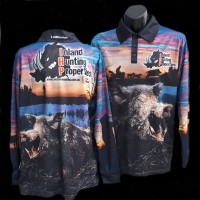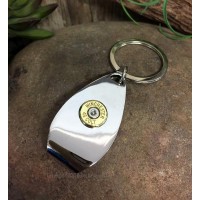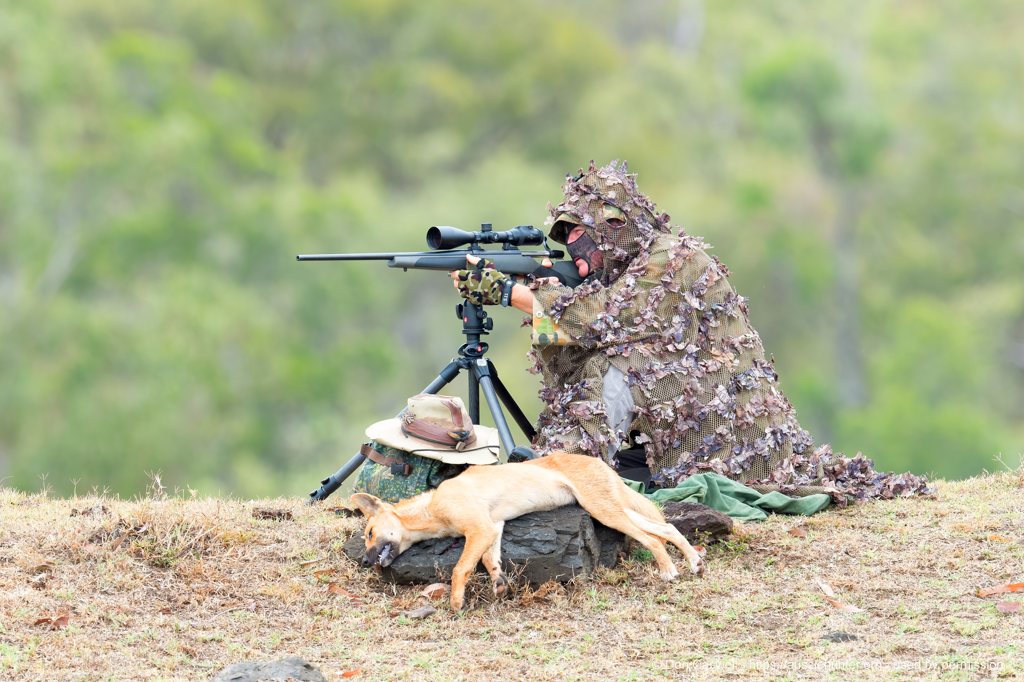
The wild dogs I account for are taken in three ways; stalking, stake-outs and chance. I reckon I enjoy stalking the most. Drifting slowly along a cattle track, stopping regularly to glass the surrounds, noting what tracks are present in the fine dust and being constantly aware of the wind requires some discipline and a lot of focussed attention. Time absolutely flies when in the zone with this game and I regularly find that what seems like half an hour can easily be the best part of a morning.
When I say morning I mean that best time of the day, from first light, when most folks are still a couple of hours off waking to their alarm. Early starts pay big dividends when hunting and that is never more so than when chasing wild dogs. Hunting wild dogs is not an office hour’s activity. You definitely want to be in action as soon as there is enough light to see by. Wild dogs are generally still on the move at that time of the day, especially around the dark of the moon when they hunt in the dawn rather than under the light of the full moon.
The full grown adult dogs will be looking to get back to their day camps after a vigorous morning hunt that may have taken them many kilometres. Particularly wary old dogs will make a point of being laid up before dawn and these cunning old so-and-sos can be very hard to come to terms with. The young adults and adolescent dogs will often stay feeding on a carcass well into the morning. For that reason, and their lack of learned wariness at that age, I find that a bit more than half the dogs I shoot are young adults or mature pups.
These younger animals are definitely a bit easier to stalk and they are likewise fatally careless in a stake-out situation. Chance encounters too are generally the younger dogs that have not yet learned to avoid man and his vehicles at all costs. A lot of younger dogs are killed in the September to February period of the year, after being chased out of home by their parents, and before they have acquired the wariness required to survive the efforts of man to kill them.
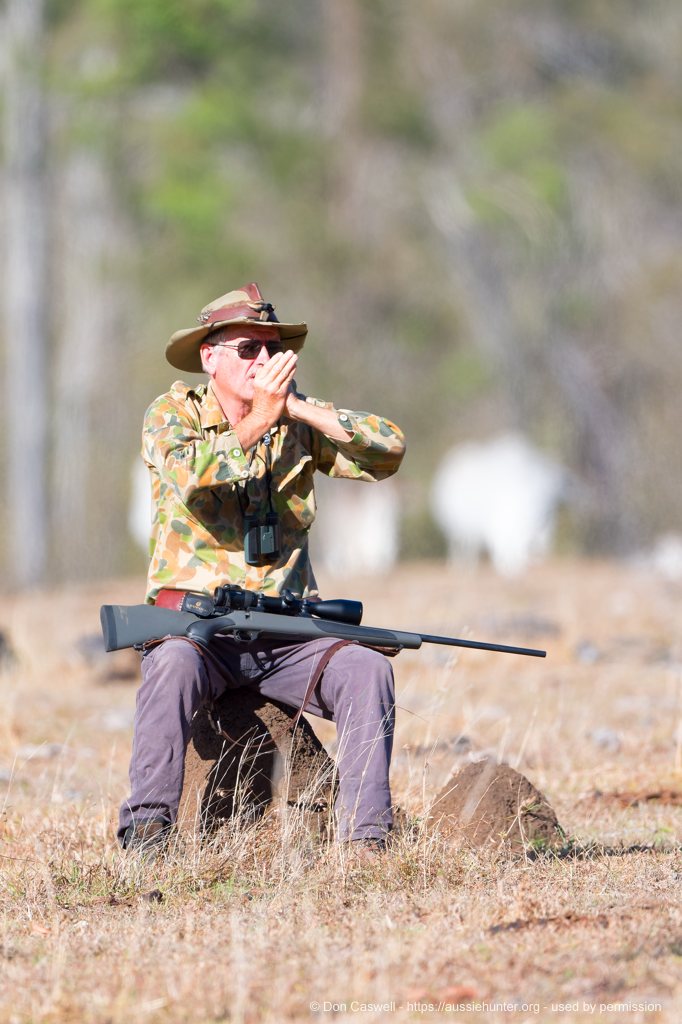
Despite what politically correct disinformation circulates about wild dogs it is an incontrovertible fact that they kill a lot more animals than they ever eat. Anybody who spends a bit of time in an area where wild dogs are active will rapidly see the evidence of that for themselves. Big male dogs, when courting a bitch in mating season, will often indulge in a killing spree, probably seeking to impress the prospective mate with their strength and vigour. When stalking such challenging quarry with my old mate, Robbie the professional dog hunter, in the ranges of central Queensland we regularly find such evidence.
On a recent hunt with Robbie we had gone on a long circuitous walk before climbing up the rough and stony slopes of the range to stalk the plateau where a pair of wary old dogs was based. The corner we snuck into was a killing ground where steep gullies and great protruding boulders formed a large semi-contained area. There were crisp fresh tracks in the dust and a lot of bones and rotting carcasses of wallaroos killed by the dogs. There were even a couple of roos killed only minutes before we arrived. The bodies were still warm and limp with blood flowing from the gashed neck where the strong male dog had bitten in and crushed the vertebra.
Sheep seem to invoke a particularly strong killing lust in wild dogs. The west is full of stories about wild dogs decimating penned sheep during the night. While strong adult dogs chase and kill prey the younger dogs are also responsible for a lot of stock and wildlife deaths as well. These mischievous adolescent dogs, like delinquent teenagers, often go on rampages. They rarely actually kill many animals during these attacks, but do bite any animal within reach. That is much more a problem than it might sound. The mouths of dogs, especially wild dogs, are full of bacteria and a bite generally leads to severe infection and often a painful death for the afflicted animal.
After a successful sale, a cattle stud close to where I live had a dozen bulls penned and ready to be collected by their new owners. Three young dogs entered the pen during the night and inflicted bites on every animal there. Naturally, the buyers then rejected the animals and a hefty veterinarian bill was incurred. Despite the best efforts of the stud and the vet, two of the expensive bulls died from blood poisoning. That is not an isolated occurrence.
Only this morning, before sitting down to write this story, I was out and about on a return visit to a cattle property. In recent days a pack of young dogs had bitten a lot of cows in a breeding herd. The owner was quite distraught when showing me a couple of fine, pregnant cows, with stiff, massively swollen legs and weeping puncture wounds. Quite likely a few cattle will lose their calves and may well die themselves. Earlier in the week I had staked out an area near the dam where the cattle water and where the attack had taken place. My hunting buddy Jan and I had managed to shoot one of the dogs.
We then stalked a couple of kilometres to another smaller dam hoping to find more dogs. When we arrived at the dam there were no dogs, but rather a mob of feral pigs. With some quick shooting we downed four big sows. Being on a wild dog hunt we only had a few rounds of ammo in our rifle magazines. Having used those to good effect we could then only watch the rest of the feral hogs run off into the bush. We dragged the four dead pigs well away from the dam and left them on the bank of a dry gully close to where the cattle track passed. This morning, on the assumption we would find dogs feeding on the pig carcasses, we made another early morning stalk. In that we were again successful and claimed another young wild dog. A couple of others fled rapidly at the first shot. I will try for those again in the coming days.

The area close to where I live has a lot of dairy farms and these too suffer from wild dog attacks. Hunting wild dogs on the smaller area of a dairy farm requires a different tactic to that used on larger beef cattle properties. Stake-outs have proven very successful for me on the dairy farms. Again, early morning starts are definitely the best option and I like to be set up well before sunrise. Shooting at long range across rolling open pastures necessitates a good rest and a flat shooting, accurate calibre. Currently I am enjoying great success with a Vanguard in 257 Weatherby Magnum. It is a fabulous choice for long shots at distant dogs. I use both the factory 100 grain soft point loading and my 110 grain Nosler Accubond handloads to equally good effect. For pure stalking, where 200 metres is the expected maximum range, I am a great fan of the 223 Remington. My Savage model 11 FCNS handloaded with 60 grain Nosler Partitions it is an excellent combination for wild dogs, and medium game in general.
In flat country, especially where there can be a mixture of stalking and impromptu stake-outs, I have used bipods to great advantage. I particularly like the 23 inch Champion bipod which has both cant and swivel; an absolute must in any bipod by the way. However, on the deeply grassed and steep slopes of the dairy farms’ ridges even the long legged bipod is just too short to give the clearance needed. In these situations I have taken to using the oddly-named, but very effective, Pig Saddle mount which allows me to use my sturdy, long-legged camera tripod. It provides a wonderfully stable mount with a great range of movement. Teamed up with the 257 Weatherby Magnum and its Swarovski z6i 2.5-15x56 scope it is an unbeatable choice for long shots in the poor light of the pre-dawn or post-sunset.
On the subject of optics, they are one of the essentials for chasing wild dogs in low light. With any game animal your chances of success are maximised if you can spot your quarry before it sees you. Good binoculars and specialist optics come into their own in these circumstances. When staking-out a valley where long shots out to 400 metres, or further, may be called for I mostly use my Swarovski 10x42 EL binoculars. When stalking with the 223 Rem I more often opt for the compact and lightweight Swarovski 10x25 CL pocket binoculars. Similarly, the superb low light performance of the big Swarovski z6i 2.5-15x56 scope, with its illuminated reticule dot is an asset for long range shots in fading light.
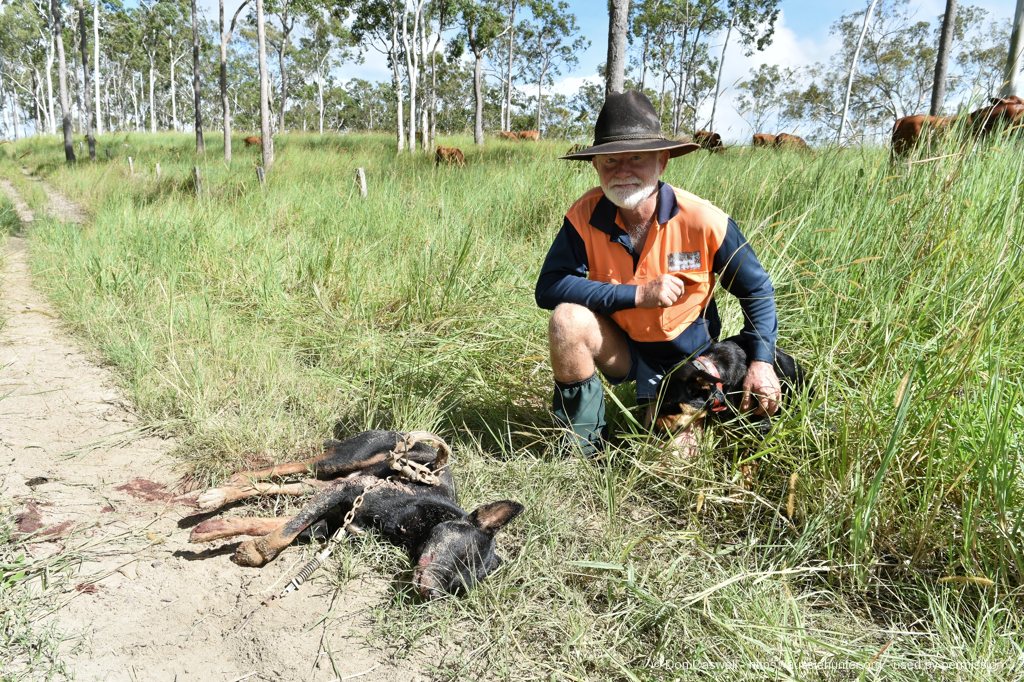
It is probably fair to say that chance can be thanked for wild dogs taken by hunters seeking other game. I have to admit that some of the particularly wary old dogs I have shot were aided by varying degrees of lady luck. Occasionally, even with cunning old dogs that have eluded bullets, baits and traps for a decade, and killed a lot of stock in the process, they can sometimes just be in the wrong spot at the wrong time. When driving about in wild dog country I generally like to poke along slowly and quietly, keeping the engine revs constant and avoiding changing gears. For me, I find the easiest way to do that is by putting the vehicle in low range 4WD, second gear, and just letting it idle along at about 900 rpm. It gives you time to have a good look about and is surprising effective in getting you close to game, especially wild dogs.
A few years back my hunting buddy Mike and I were checking out a new location, a large cattle station that was suffering a lot of dog problems. The owners had given us a mud map, and few directions, after which we spent the morning driving about getting our bearings. We had stopped for a cup of tea and snack late morning. It was a promising looking spot, so I gave the predator squealer a few raucous bleats and kept my 223 Rem handy while sipping my tea. About five minutes later, a pair of dogs showed up, sighted us and bolted. I took a long running shot and had the great satisfaction of seeing the bullet strike home. It turned out to be a big old male dog. The bitch with him made good her escape.
Driving back to the house we came upon one of the workers who knew why we were there. He asked how we were going and was visibly pleased when he heard we had dropped a dog already. He asked a few pertinent questions about the location and of the dog itself and then said, “By golly that old bastard has killed a lot of calves. He wouldn’t go near a bait or a trap and has had more hot lead thrown at him than the mound at the rifle range.” The owner was equally happy with our chance result and it did not do our reputation any harm either.
People who know I spend a lot of time chasing wild dogs often comment that I must hate them a lot. Not at all. In fact, I am particularly fond of dogs in general, finding them a pleasant, affectionate and sociable creature with a good sense of humour. Unfortunately, sometimes the only effective option for wild dog control is poison and trapping. Personally, I would much rather hunt them by stalking or sitting over a stake-out.
https://www.westernhunting.com.au/index.php/wild-dog-hunting#sigProIdfc5b95d6c2
© Don Caswell 2016


